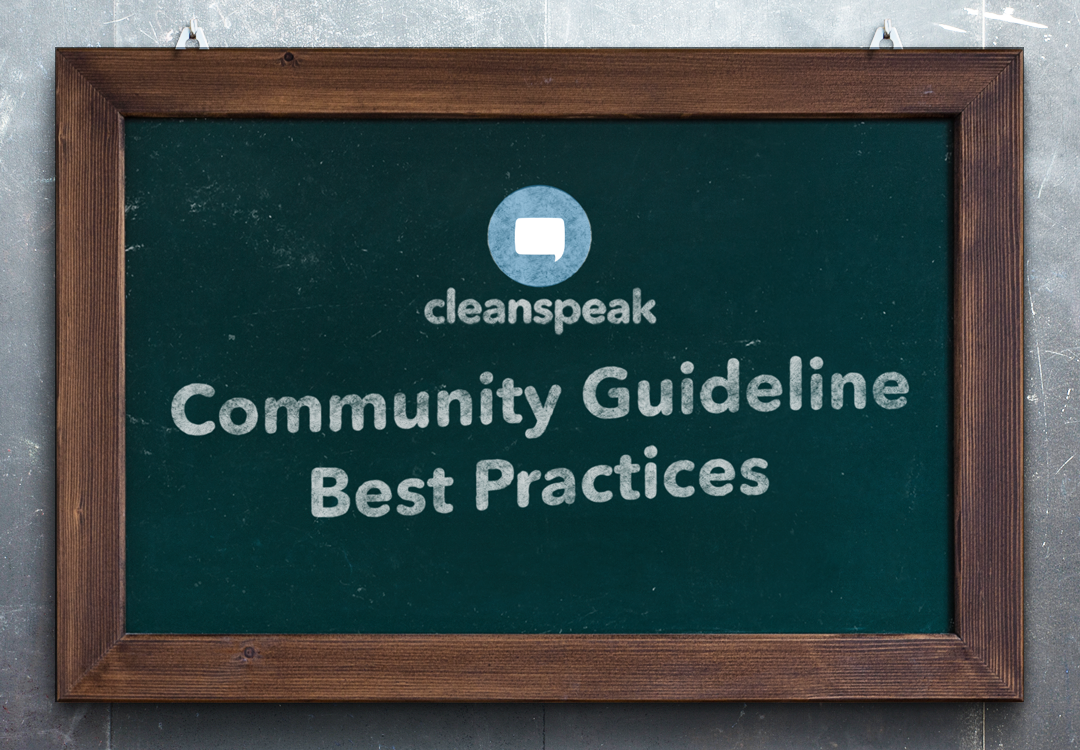Community Guideline Best Practices and Examples

- By Blair Ewalt
- CleanSpeak, Strategies
- May 6, 2022

Community guidelines are the rules of the road on how to behave. Your community guidelines will help mold your community to your vision, and in turn promote a healthy discourse as well as user retention and growth.
When running an online community, whether it is a forum, chat room, game, sharing economy app, or other platform that allows user-generated content, it is imperative to set out community guidelines to lay out your cultural objectives and make taking action against your users or their content justifiable. Community guidelines are the rules of the road on how to behave. Your community guidelines will help mold your community to your vision, and in turn promote a healthy discourse as well as user retention and growth. In this article, we will discuss some of the best practices around community guidelines and look at examples of how companies are utilizing them today.
Define your community purpose or values
First, lay out your purpose or your values. These should be short and concise with little ambiguity. Whether you decide to start with your purpose or your values is up to you, and there are great examples of both. Expressing your purpose and values is an important guiding north star which leads your community to success from the beginning.
Twitter starts their community guidelines with a simple purpose statement before talking about their user limitations. “Twitter’s purpose is to serve the public conversation. Violence, harassment and other similar types of behavior discourage people from expressing themselves, and ultimately diminish the value of global public conversation.” Twitter goes on to list their community rules and appeals process.
Buffer lists their community values as Positivity, Courage & Respect, and Thoughtful Language with explanations of what each value means to them, and what they should mean to the community.
Encourage, do not discourage
Rules of encouragement can lead users in the right direction to effectively utilize your community. These can include descriptors of what the platform should be utilized for. For example, in your guidelines you can encourage your users to use your community to share questions when they are in need of help, answer questions for others, start and join in on discussions, share helpful tips, or talk about your product, to name a few. It is commonplace to set out a list of rules in a section which defines what is allowed and what is not allowed.
Vodaphone UK does this by encouraging their community to be nice and share their knowledge for others if it should be useful. They even encourage users to say thanks when they’ve been helped by others. Vodaphone UK has a very succinct summary of their community rules within their guidelines where they offer a list of “please do’s” and “please don’ts.”
It is very important when writing your community guidelines to not disparage or belittle people, including calling out peoples’ morals, justifying violence, claiming them as criminals, referring to them as inhuman, or promoting discrimination. Your community guidelines may be the first thing people see when they join your community, so you want to set a good example from the beginning.
Get your guidelines front and center
How many times have you signed up for something and checked the boxes “I have read and agree to the terms and conditions” and “I have read and agree to the community guidelines,” without actually reading either of them? It may be one of the biggest lies of the internet, especially since companies have been known to bury things in their terms and conditions expecting people not to read them.
For example, Apple says no matter if you buy music off their store, you still do not actually own it, only the right to listen to it (if you dig in, they also say you cannot use any of Apple’s online stores to create biological weapons… makes you wonder what happened there). When you sign up for Spotify, you give them access to all the data stored on your phone. A Finnish IT security company, F-Secure, once added in a clause in their free Wi-Fi hotspot saying “the recipient agreed to assign their first born child to us for the duration of eternity,” just to see if anybody was actually reading.
The point is this, if you can present your community guidelines in a concise manner to your community as they sign up, they are more likely to actually read them. Dating apps usually are very upfront with this. One example is Bumble who presents their community guidelines right as users sign up. If users get the short and sweet during the signup process with a link to expand, they can understand the general gist of what you’re getting at, instead of ignoring it altogether.
Be transparent and have consistency in moderating content
If you want to keep your community happy, you will want to start by laying out your community rules inside of your community guidelines. Your rules should be straightforward. What is not allowed in your community?
Lyft explains their rules in the context of their values in a positive light. For people not willing to comply with their rules, they include another section, “What if these guidelines aren’t for me?” where they tell their community, in short, these rules may not be for you, but if you are not going to follow them, you will be banned.
Rules are helpful as they lay out a framework for your moderators to consistently follow which provides your users with a sense of continuity and transparency. It puts all users on a level playing field.
Another measure of transparency is letting people know about your tolerance policy. Is there a penalty for repeat offenders? What will happen if the user goes against the community guidelines? Are you just removing their content or banning them as a whole? How much bad behavior is allowed?
Some platforms give users the ability to report content natively inside of their app. Google Help adds in their participation agreement, “If you believe that someone is violating these posting guidelines, flag their post or thread for review: […] Report Abuse.” You may want to consider laying out the workflow so your users can help you align your community with your guidelines.
Other best practices
- Keep your user guidelines updated. As your community evolves you may need to change certain facets of your guidelines to keep your community as you would like it and your brand reputation intact.
- Allow a space for open discussion about your community guidelines. Whether by email, on your channels, etc. Keep people involved so that if they have any problems, they can reach out to whoever is in charge. This can also help boost transparency.
- If you want to foster a strong community, try to refrain from being “power crazy,” for lack of a better term. If you see a conversation you do not like there are many opportunities to try to resolve the issue before taking drastic action such as banning a user. Some actions include steering conversations in other directions (in the case of public forums), or reaching out to community guideline breakers individually.
- Do not be afraid to have fun with it if it makes sense for you. Many of the community guidelines examples linked above help set the tone they would like for their community right from the beginning.
Conclusion
When you create strong community guidelines and present them in an upfront manner to your users you are laying the foundational bricks for what your community will become. Your guidelines are important to fostering a healthy community, so take the time to encourage your community using the best practices described above.